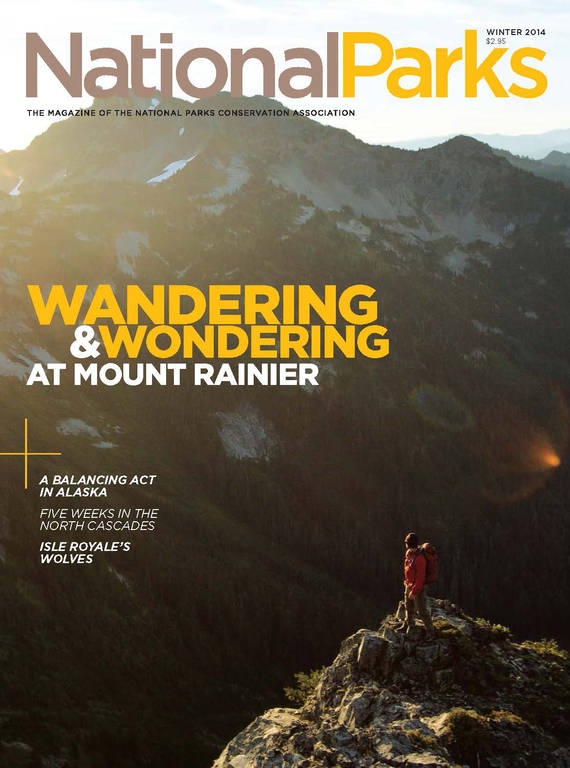Winter 2014
Between a Bog and a Hard Place
Biologists in Washington State are calculating the best way to save crucial habitat for the Cascades frog.
Late September isn’t the coldest time of year to be in the Seven Lakes Basin of Olympic National Park, but it’s getting there, and so it is with no small amazement that Wendy Palen and I watch Maureen Ryan wade into an alpine pond up to her waist.
“Cold?” Palen asks from the shore, where she is nice and dry.
“It’s actually not too bad,” Ryan says as she rolls up her sleeve and roots around the bottom. She’s searching for a device she placed in the center of the pond last spring, which has been tracking its temperature for several months. By comparing the data from another temperature logger placed on the shore with the one she soon wrests from the muck, she’ll be able to see whether the pond dried out completely during the summer. This, in turn, will help her predict the survival prospects of amphibians in the alpine wetlands of the American West.
TAG, YOU’RE IT
Palen and Ryan are biologists from Simon Fraser University and the University of Washington, respectively. For the past two years, the two of them have waded into ponds in the high alpine regions of three national parks in Washington— North Cascades, Olympic, and Rainier—in search of Cascades frogs. Tough and elusive, Cascades frogs live only in alpine wetlands in the Pacific Northwest and are rarely found below 2,000 feet in elevation. And, for Palen, they are the perfect animals to illustrate what she calls “the amphibian squeeze.”
Throughout the American West, she argues, amphibians have endured—are enduring—two massive unintended experiments. One is climate change. Cascades frogs and other amphibians, like the long-toed salamander, need snow. After spending much of the year under several feet of it, Cascades frogs emerge in the late spring and summer to mate. Females lay their eggs in small seasonal ponds that are fed primarily by snowmelt. The tadpoles grow throughout the summer and, after two to three months, metamorphose just before the first snowfall.
It is a finely tuned system that requires a lot of snow. When there is less of it, as is predicted with climate warming, the ponds are shallower and thus more likely to dry up. Palen and Ryan sometimes find little piles of desiccated tadpoles on the cracked muddy bottoms of empty ponds, where the last puddles lingered.
For the frogs and salamanders, the solution would seem fairly straightforward: Simply move downslope to lakes and ponds that are less likely to dry out. But that brings Palen to the second experiment and the force that’s squeezing amphibians from the other side. In the 1800s, settlers, and later fish and wildlife managers, stocked many of those ponds and lakes with trout—first for food, and then to promote recreation. (Although official stocking was discontinued years ago, some dedicated anglers still pack trout into backcountry lakes.)
Once in the lakes, the trout were efficient predators and duly ate almost all the amphibians that lived there. The only places frogs and salamanders are still found in any great number are lakes without trout—a relatively rare commodity—and those many small ponds scattered throughout the landscape that are most at risk for drying out.
To aid amphibian communities, and as part of a larger climate-adaptation strategy, some national parks are considering removing fish from what were naturally fishless lakes. But that is a long and difficult process. Biologists must visit targeted lakes frequently for five years or more, catching trout with gill nets until all of them are gone. In larger lakes where gill-netting is unfeasible, pesticides are sometimes used, which brings an entirely different set of challenges.
To help park biologists determine where best to spend their money and time, Palen and Ryan are developing a model that will prioritize lakes for fish removal by showing which are most likely to persist in future climate scenarios. “It’s a question of getting the most bang for your buck,” Palen says.

National Parks
You can read this and other stories about history, nature, culture, art, conservation, travel, science and more in National Parks magazine. Your tax-deductible membership donation of $25 or more entitles…
See more ›In North Cascades National Park, where fish removals have been under way since 2009, the benefits to biotic communities are already apparent, says Regina Rochefort, the research coordinator for the park. Frogs, newts, salamanders, and toads have already started to recolonize lakes recently cleared of fish. Some anglers aren’t very happy about it, though. Rochefort and fellow biologists have discovered trout in a couple of the lakes where fish had been completely removed. “We just have to go in again and get them out,” she says. The park has launched educational outreach efforts to inform people about the benefits of fish removal.
For their part, Palen and Ryan will return to their study sites next spring and summer, to see which ponds have dried out and which ones haven’t. They will place their temperature loggers and hunt for the frogs that lurk in the surrounding vegetation. But now, in the face of the cold and the coming snows, most of the frogs are nowhere to be found. Where exactly they go during the winter is unknown, even to Palen, who has studied them for almost 15 years. For her, though, this is part of their appeal—the way they show the rigors of an alpine life. “They’re really hardy, really mysterious,” she says.



